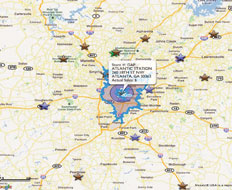Quick serves are refining how they use geographic data to create benchmarks for optimal store operations. Today’s tools can help them capture both psychographics as well as demographics. In fact, with iPad in hand, site-selection managers can use cloud computing to bring store analytics to operators.
“If you think of data in the purest raw format, 80 percent of all data has some geographical component,” says Charles Wetzel, president and CEO of marketing services firm Buxton. His company draws geographical data from 250 sources, helping quick serves refine the art of choosing a new market.
Geographic information system (GIS) technology—which creates a system of storing and analyzing geographical data—has been around for years now, but new tools and technology are making it more useful for the quick-service industry.
The big news is growth in tablets and smartphones, Wetzel says. Through cloud computing, quick-serve real estate managers in the field can tap GIS data. He says efficiency gained through portable devices “is where the value is.”
Before the housing crash, there were about seven variables that everybody used to determine site selection, says Simon Thompson, director of commercial solutions for Esri, a geo-solutions provider. “That was OK, because if you put your roots down you succeeded,” he says. Recessionary pressures have subsequently led quick serves to fine-tune GIS application for better selection.
A market area is “a constantly moving amoeba” that changes shape and direction throughout the various dayparts, Wetzel says.
In fact, Thompson says, psychographics are more important than demographics when it comes to determining the best store sites—something GIS helps calculate.
“What are people’s behaviors and lifestyle characteristics?” he says. “[An operator will] say, ‘We get 40-something moms come in with their kids, and they want a kid’s meal and coffee. After 2:30 p.m., when the high school closes, all these kids come in. Cops turn up at eight at night.’
“So what they’re doing is they are taking that internal view of their customers, and modeling and profiling that against the marketplace.” Operators then assess how close a store matches marketplace operations, he says.
Rapid changes in a neighborhood can result in faulty site analysis, meaning site selectors need to stay on their toes, Thompson says. He points to the “Starbucks effect,” in which speculators placed bets on homes near Starbucks because the quick serve’s arrival signals gentrification.
“People basically said, ‘If they’re opening a Starbucks, they’re so great at demographics that they know something about the number of people that are going to go there, so let’s buy a house near to that,’” he says. “And that was one of the investment models that residential real estate bought into. But, as soon as residential real estate got into it, it actually, in many ways, defeated Starbucks.”
Thompson says in the past five years, companies have moved away from thinking, “‘We need to open here,’ to actually asking: ‘What type of format do we need in those locations?’” Rather than running numbers on a single site, operators now use GIS data “to analyze thousands of sites, and compare the best ones.”
Operators then map out opportunistic areas, or “hyper local models,” he says. “So now, rather than being a site-selection problem, it’s an operational problem. Now it’s about, how do we market better? How do we improve the loyalty?”
Culver’s incorporated GIS into site selection in 2007, says Dave O’Brien, real estate manager for the company. “There’s more knowledge out there about GIS, so [operators] ask more important questions about getting the right site for their use,” he says.
O’Brien says using Tapestry Segmentation (a system that helps classify specific markets) goes past collecting raw numbers of population density or employment statistics.
“It gives us further learning into the demographics of our guests in the restaurant,” he says. “We can take that in many, many different directions, and find out what really makes our guests tick, and what they like to see. Obviously right now, with unemployment being an issue across the country, I think the quicker the updates, the better.”
Buxton, which counts Fuzzy’s Taco Shop and Smashburger among its clients, is investing heavily in exploiting geo-sourced social media data, with plans to add that capability to the company’s existing GIS toolset, Wetzel says.
Sara Wilkins, director of real estate for Schlotzsky’s, says the company has about 350 stores and now uses a GIS solution for new sites. The Strategic Integrated Mapping and Modeling System (simms) was developed for the company by Forum Analytics LLC, a Chicago-based firm.
“We still have a lot of very, very green markets,” she says, referring to underdeveloped metros. The company has a goal of franchising five to 10 stores at a time, and uses SIMMS as a starting point in those new markets.
Powered by data that includes geo-coding of the company’s competitors, leasing information, and tenancy data, SIMMS has helped new franchisees negotiate favorable deals with landlords, Wilkins says.
“GIS data narrows a range of what the franchisee might expect in a [new] store, along with comparable data from similar markets, and it gives a franchisee a snapshot of what surrounding stores do in that market,” she says.
“I can’t give them a sales claim. What I can do is say, ‘Hey, this is kind of what other Schlotzsky’s do that look like this [one].’”
“America is sort of awash with information and has an open-data program,” Thompson says, adding that achieving the same level of sophistication in GIS analysis may not be possible or even necessary overseas.
“It’s not about where people live, it’s about where people interact,” and the same [GIS] concepts can be “transposed to almost any city or at a national level.”
“I’m not really aware of a brand out there that isn’t using GIS,” O’Brien says. “We believe we owe this knowledge, and this research and analysis, to our franchisees to help them make the best informed decisions.”








